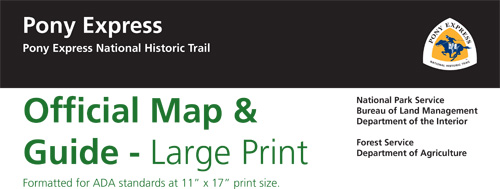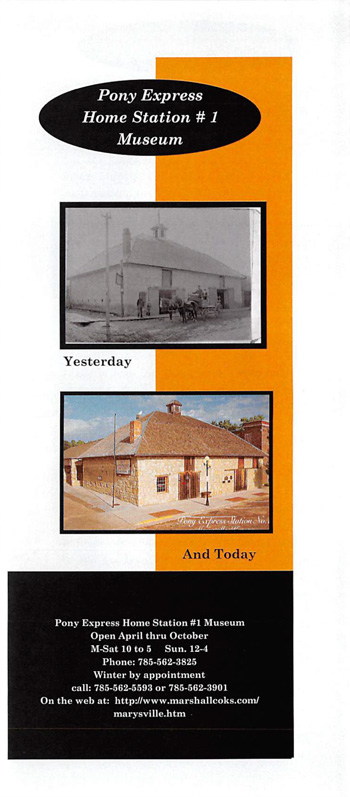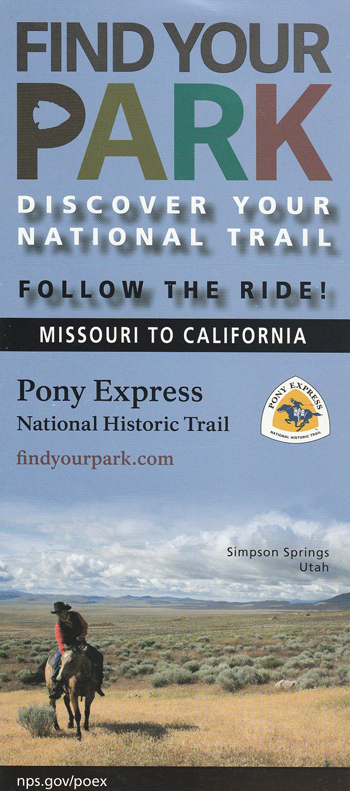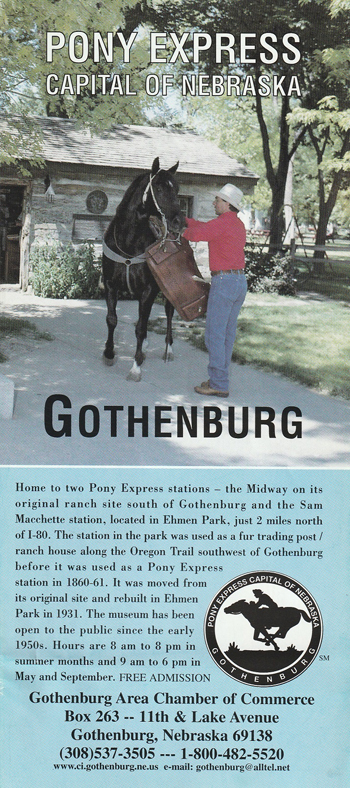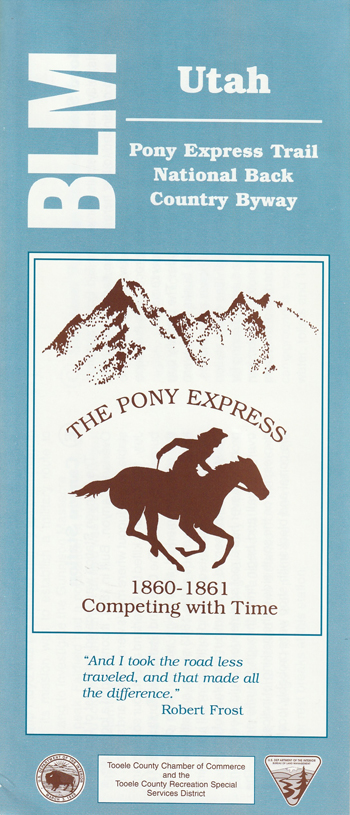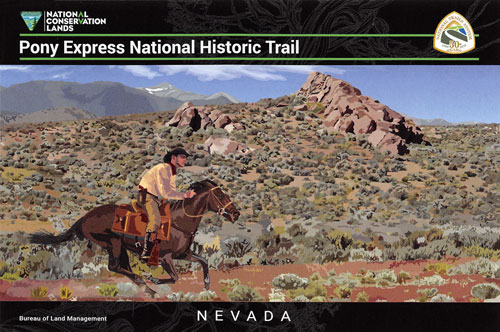|
Pony Express National Historic Trail CA-CO-KS-MO-NE-NV-UT-WY |
 |
 NPS photo | |
Here Comes the Pony
The Pony Express has fascinated Americans since its first riders hit leather in April 1860, heading west from St. Joseph, Missouri, and east from San Francisco, California. This innovative overland mail service lasted only 19 months, but it created an immediate sensation and won a permanent place in the history of the American West. The legend of "the Pony," as it was affectionately known, may overshadow its brief history, but the bold founders and brave riders of the Pony Express helped spread important news, shrink a continent, and bind a nation that was being torn apart by civil war.
"The pony-rider was usually a little bit of a man, brimful of spirit and endurance."
—Mark Twain
Overland Mail
The idea behind the Pony Express, a horseback relay mail service, goes back to at least ancient Rome and Persia. In 13th-century China Marco Polo described a "system of post-horses by which the Great Khan sends his dispatches." Oregon missionary Marcus Whitman in 1843 proposed using horse relays to deliver mail from the Missouri River to the Columbia River in 40 days. But in 1845 it still took six months to get a message from President James K. Polk to California. By the late 1850s a half million people Immigrated West, and they wanted up-to-date news from home. Something had to be done to deliver mail faster and to improve communication in the expanding nation.
News from home! The emigrants who moved West in the mid-1800s anxiously awaited mail from home. But mail took months to arrive, and by then the news was old. Westerners demanded better mail service. Congress established postal service to the Pacific Coast in 1847 and, in 1851, set the rate for a half-ounce letter at three cents for delivery if less than 3,000 miles and six cents if it went farther. Private contractors handled the business, which required huge government subsidies. With the discovery of gold, followed by statehood, California's population mushroomed, increasing the urgency for better communication. In 1848 the U.S. Post Office awarded a contract to the Pacific Mail Steamship Company to carry mail to California. The mail traveled by ship from New York to Panama, moved across Panama by rail, then by ship again to San Francisco. The goal, getting a letter from the East in three to four weeks, was seldom met.
The government struggled to improve transcontinental mail service. In 1855 Congress even appropriated $30,000 to see if camels could carry mail from Texas to California—they proved impractical. John Butterfield won a $600,000 contract in 1857 that required mail delivery within 25 days. His overland stagecoach service began in 1858 on a 2,800-mile route that left Fort Smith, Ark. and reached San Francisco via El Paso, Tex. and Yuma, in Arizona Territory. Despite its length and scarcity of water, no snowbound mountains blocked this route. Powerful southern political interests kept government subsidies on these southern trails. With civil war threatening to close southern routes, northern politicians sought a central route. Benjamin F. Ficklin had carried U.S. Army dispatches from Utah Territory and proposed that the government could provide express mail service using a horse relay. California Sen. William Gwin backed the idea.
Chimney Rock was one of the most famous landmarks along the trail—a wonder of nature and an important milepost, 556 miles west of St. Joseph, Mo.
Planning the Pony Express
Seize the Opportunity William H. Russell of the freighting firm of Russell, Majors & Waddell created the Pony Express almost by accident. Russell, William B. Waddell, and Alexander Majors were Missouri business partners with vast experience hauling cargo and passengers—and a great interest in government mail contracts. Their firm already provided mail and stagecoach service between the Missouri River and Salt Lake City.
Russell felt that a horse relay, a Pony Express, would promote his company and gather congressional support to win the mail contract for a central overland route. He was confident this expensive advertisement would pay off in the long run, although Majors and Waddell were not so sure. With the backing of Senator Gwin but to the dismay of his partners, Russell committed to opening the express mail service on the central route in April 1860.
The three partners started a new firm, the Central Overland California & Pike's Peak Express Company (C.O.C.& P.P.)—the official name of the Pony Express. Russell raised money in New York and political support in Washington, D.C.; Majors managed daily operations; and Waddell ran the home office. The company had 67 days to hire riders, station keepers, and mail handlers and buy horses, food, and other supplies and distribute them to stations across the route (some were not yet built or even located).
Majors organized the route into five divisions, numbered east to west. The first leg ran from St. Joseph, Mo., to Fort Kearny, Nebraska Territory on the Platte River. The second went to Horseshoe Station near Fort Laramie, Wyoming Territory. These traced the route of the Oregon and California trails, with a dip into today's Colorado at Julesburg. The third took the emigrant trail to Fort Bridger and the Salt Lake Valley in Utah. The fourth, to cross the Great Basin, followed a route opened in 1858 by James Simpson that ran south of the Great Salt Lake desert to Roberts Creek Station, north of today's Eureka, Nev. The fifth leg was the toughest of the trip, crossing the Nevada desert and rugged Sierra Nevada, finally arriving at Sacramento and San Francisco, Calif.
C.O.C.& P.P. established home stations every 75 to 100 miles (to house riders between runs) and smaller relay stations every 10 to 15 miles (to provide riders with fresh horses). The names of some of the Pony stations—Kearny, Chimney Rock, Scotts Bluff, Fort Laramie, Sweetwater, Fort Bridger—were already famous in western history. Many were upgraded from existing stagecoach stations, but some stations were built from scratch. The operation expanded from 86 stations on the Pony's first run to 147 stations by mid-1861.
Devils Gate, a cleft carved by the Sweetwater River, is 370 feet deep, 1,500 feet long, and about 50 feet wide. Riders passed this Wyoming Territory landmark at milepoint 829 on their way west.
God Speed to the Boy and the Pony
"Men Wanted! . . . Men familiar with the management of horses, as hostlers or riders on the Overland Express Route via Salt Lake City. . . Wages $50 per month." Sacramento Union, March 19, 1860
So announced newspaper ads. Hires ranged from teenagers to about age 40. Weight restrictions were strict. Riders had to weigh less than 120 pounds and carry 20 pounds of mail and 25 pounds of equipment.
Some riders were given an inscribed leather Bible. Employees took this oath: "While I am in the employ of A. Majors, I agree not to use profane language, not to get drunk, not to gamble, not to treat animals cruelly, and not to do anything else that is incompatible with the conduct of a gentleman. And I agree, if I violate any of the above conditions, to accept my discharge without any pay for my services." The job was exacting and not for the faint of heart.
The company employed between 80 and 100 riders and several hundred station workers. Riders earned wages plus room and board. They joked that the company's initials, C.O.C.& P.P., stood for "Clean Out of Cash & Poor Pay." The Pony employed some characters—not all living up to the pledge of obedience and abstinence befitting a gentleman. Division Superintendent Jack Slade ran wild when drunk but "kept the road cleared of robbers and horse thieves." Some say Assistant Station Tender James Butler "Wild Bill" Hickock shot agent David McCanles and two others at Rock Creek Station in Nebraska. "Buffalo Bill" Cody never rode for the Pony Express, but he used his Wild West Show to promote the Pony's legend and romance.
Horses were selected for swiftness and endurance. Russell advertised for "200 grey mares, from four to seven years old, not to exceed fifteen hands high, well broke to the saddle and warranted sound." The company bought 400 to 500 horses, many thoroughbreds for eastern runs and California mustangs for western stretches. Horses averaged 10 miles per hour, at times galloping up to 25 miles per hour. During his route of 75 to 100 miles a rider changed horses eight to 10 times.
Mail traveled in four, locked leather boxes sewn onto the corners of a leather mochila (knapsack) that fit over the saddle. The design allowed for fast removal and placement on a fresh horse. The exchange of horses and mail was more casual than legend has it. Riders often stopped to eat or drink and stretch their legs, but Mark Twain wrote that the "transfer of rider and mail-bag was made in the twinkling of an eye." Twain also reported that from his stagecoach he "heard only a whiz and a hail, and the swift phantom of the desert was gone before we could get our heads out of the windows."
Riders heading West from Utah's Boyds Station faced a long stretch across the lower Great Salt Lake Desert and the distant Deep Creek Range.
Great Race Against Time
The First Rides On April 3, 1860, after weeks of frenzied preparation, the day for the first rides arrived. The St. Joseph Daily Gazette declared it would "forward, by the first Pony Express, the first and only newspaper which goes out, and which will be the first paper ever transmitted from the Missouri to California in eight days." This Pony Express Edition also announced, "The first pony will start this afternoon at 5 p.m. precisely." The westbound rider actually left at 7:15 p.m. reportedly carrying five telegrams, 49 letters, and newspapers printed on lightweight paper "as airy and thin as gold leaf." The eastbound mail left San Francisco at 4 p.m., traveling by the paddle steamer Antelope to Sacramento. From Sacramento, rider Sam Hamilton blazed east, changing horses six times, and passed the mochila to Warren Upson who took the mail over the Sierra Nevada in a blizzard. East and westbound riders passed each other on April 8, west of today's Farson, Wyo. Bands, banners, bells, and occasionally "a wild cavalcade of men" greeted riders along the way. After covering nearly 2,000 miles, the eastbound mail reached St. Joseph on April 13. The reception was tumultuous, with bands and cheering people lining the streets. In Sacramento a mounted escort and cannon fire greeted the Pony rider. The westbound mail arrived in San Francisco about 1 a.m. on April 14. Thousands of people turned out to watch the Antelope arrive with the first mail. The crowd lit bonfires and held a boisterous celebration.
The Pony Express charged five dollars per half-ounce for mail (about $85 in today's money), later reducing the fee to one dollar. At first the Pony ran once a week in each direction. Starting in July 1860 it ran a second weekly trip, delivering mail in 10 days or fewer between St. Joseph and San Francisco.
Only once did the mail not go through. The service suspended operations from May to late June 1860 during an Indian uprising. Over the winter Paiutes in Nevada endured harsh weather and faced starvation. They blamed the thousands of miners who destroyed Indian food and water sources as they dug for gold and silver. Tensions grew, and the Pony became a target. Paiutes razed relay stations, killed employees, and drove off horses. The disrupted service brought heavy financial losses to the already struggling company.
The greatest challenge to the Pony proved to be not Indians but winter weather. Freight roads to the Nevada mines kept Sierra Nevada passes open during much of the winter, but snows that buried the high country between Salt Lake and Fort Laramie often proved t o much for a single rider. Still, delivery continued even during January with only a four- to six-day delay.
East of Fort Churchill Pony riders and horses endured a treacherous expanse with no water.
An Enduring American Legacy
Risky Business—Legendary Payoff The Pony Express was as risky a venture as any taken on the frontier. Russell, Majors & Waddell had survived on loans made against its government debts since 1858, and the company was essentially bankrupt when it launched C.O.C.& P.P. Russell counted on winning the central overland mail contract to revive the company's fortunes, but Congress adjourned in June 1860 without taking action. Russell tried to save the business by secretly borrowing bonds through a friend in a government agency. The story became public in December 1860, leading to a scandal and Russell's arrest. He beat the embezzlement charges, but the troubles spelled disaster for the Pony Express. With the start of the Civil War in 1861 Congress appropriated money to support the overland mail, after the secession of Texas closed the southern routes. But the contract went to Butterfield's Overland Mail Company not to the Pony Express. Officially the Pony Express ceased operations with the completion of the transcontinental telegraph on October 26, 1861. The Pony made its last run on November 20, 1861. It completed some 300 runs each way over 600,000 miles and carried more than 33,000 pieces of mail.
The Pony's achievements in spreading news and uniting the nation were significant. By early 1861 war between the North and South seemed certain. Whether California decided to remain in the Union depended, in part, on policies presented in Abraham Lincoln's inaugural address. The Pony delivered Lincoln's March 4 message to California in the fastest time ever—seven days and 17 hours—bringing news that helped the state stay loyal. In April 1861 the Pony delivered word of the outbreak of the Civil War. Until the Pony's last run in November 1861 it brought news of battles and lists of dead and wounded to anxious westerners.
In its 19 months the Pony Express captured the hearts and imagination of people around the world and marked a milestone in our nation's communication system. The abiding fascination with the Pony's story is one of its enduring legacies. The Pony Express lives on today—in books and movies and with thousands of people who love its history. Each year since 1978 the National Pony Express Association rides the trail in a 10-day, round-the-clock, non-stop event. More than 500 riders follow a 1,943-mile route that is close as possible to the original trail. Today Pony riders use short-wave radios and cell phones to spread the news of their journey.
In 1861 newspapers paid tribute to the Pony's accomplishments: "You have served us well." The Sacramento Daily Bee bid "Farewell Pony!" and saluted the "staunch, wilderness-overcoming, swift-footed messenger" that had "dragged in your train the lightning itself."
The Sacramento River was a welcome sight for a westbound rider. Here he handed off the mail to a messenger on a waiting paddle steamer who delivered it to San Francisco.
Spreading the News
For millions, email and the Internet have replaced letters and newspapers. But, how did we communicate 50, 100, or 600 years ago? Below are highlights of some key people, inventions, and technologies that changed how we spread the news.
1454
Johannes Gutenberg invents a printing press with metal, movable type. The press
enables the mass production of documents that spread news and exciting ideas of
the Renaissance.
1769-1807
James Watt perfects the steam engine. Benjamin Franklin becomes first Postmaster
General under Continental Congress. Robert Fulton's steamboat Clermont
begins passenger and mail service on the Hudson River.
1830-1832
U.S. rail service begins from Baltimore to Ellicott's Mills, Md., 16 miles west.
Steam locomotive sets record speed of 30 miles per hour. Mail delivery by rail
begins in Pennsylvania.
1837-1844
Samuel Morse develops telegraphy, a method of sending electronic messages over
wires. Morse patents dot-and-dash alphabetic code. First U S. news sent by
telegraph: Henry Clay is Whig party nominee for President.
1860-1861
Pony Express begins mail service April 1860 between St. Joseph, Mo. and San
Francisco, Ca. Transcontinental telegraph lines completed, October 1861. The
Pony delivers last mail November 1861.
1868
First successful telegraph cable operates between England and Canada, with land
lines to U.S. Transatlantic news is delivered at speed of two words per minute,
beating the next fastest method—10 days by steamship.
1869
Union Pacific and Central Pacific connect rails at Utah's Promontory Summit.
Transcontinental train service begins for passengers and mail.
1876-1877
Alexander Bell invents telephone. Thomas Edison records and plays back sounds
cut into grooves on a wax cylinder. First recorded words: "Mary had a little
lamb." Eadweard Muybridge demonstrates high-speed photography.
1896-1901
Guglielmo Marconi tests and patents wireless telegraphy (radio); transmits
signals from England to Newfoundland. Proves messages can be sent on
electromagnetic waves, roughly at speed of light. Valdemar Poulsen develops
magnetic recordings, basis for today's data storage on disk.
1903
Pres. Theodore Roosevelt sends first public wireless message (to England's King
Edward VII), sparking a revolution in global communication. Orville and Wilbur
Wright take turns flying first motor-driven airplane at Kitty Hawk, N.C. Last
flight of the day: 852 feet in 59 seconds.
1906-1915
Lee DeForest invents triode vacuum tube amplifier makes possible long-distance
telephone calls; paves way for sending voice by radio. Woodrow Wilson, calling
San Francisco from White House, says, "It appeals to the imagination to speak
across the continent."
1926-1927
Sparton Corporation introduces electric radio. AT&T demonstrates
television—team in New York hears and sees Secretary of Commerce Herbert
Hoover from Washington, D.C. Hoover says, "I am glad to welcome television as
the latest product of scientific discovery."
1946-1948
Researchers build ENIAC, the first all electronic digital computer with input,
output, and memory; it has 18,000 vacuum tubes and fills several rooms. First
live telecast of baseball's World Series: New York Yankees beat Brooklyn
Dodgers. Scientists invent transistor, setting stage for microelectronics.
1960s
"Live via satellite." Telstar 1, first active telecommunications satellite,
ushers in era of real-time global TV transmissions. Department of Defense
develops Advanced Research Projects Agency Network (ARPANet), an information
networking system, precursor of the Internet.
1970-1980s
Altair Microcomputer Kit—first personal computer—is marketed to home
enthusiasts. Radio Shack introduces first fully assembled personal computer with
keyboard and monitor. BITNET (Because It's Time NETwork) provides file transfers
and email.
1990s
Computer scientist Tim Berners-Lee develops World Wide Web. Entire encyclopedia
stored on CD-ROM. Wireless applications allow access to the Internet via cell
phones. Instant messaging skyrockets. Millions worldwide use email and the
Internet.
2002-2003
In U.S. more email messages sent than postal mail. FCC reports 122.4 million
wireless phone subscribers in U.S. Networks send more than six trillion bits of
data par second over fiber optic lines, about one million images per second.
More Information
 (click for larger map) |
The Pony Express National Historic Trail, authorized by Congress in 1992, is administered by the National Park Service and managed by the Bureau of Land Management, USDA Forest Service, other federal agencies, state and local governments, and private landowners.
National Park Service
National Trails System
Salt Lake City
P.O. Box 45155
324 South State Street
Salt Lake City, UT 84145
www.nps.gov/poex
Bureau of Land Management
National Historic Trails
1501 North Poplar
Casper, WY 82601
www.blm.gov
USDA Forest Service
Intermountain Region
Federal Building
324 25th Street
Ogden, UT 84401
www.fs.fed.us
USDA Forest Service
Pacific Southwest Region
1323 Club Drive
Vallejo, CA 94592
www.fs.fed.us
Pony Express Trail Association
139 San Antonio Way
Sacramento, CA 95819
National Pony Express Association
P.O. Box 236
Pollock Pines, CA 95726
www.xphomestation.com/npea.html
Internet Information
www.nps.gov/poex
www.nps.gov/poex/hrs/hrs.htm
www.xphomestation.com
www.americanwest.com/trails
www.ci.st-joseph.mo.us/pony.html
www.usps.com/history
www.sfmuseum.org
www.ponyexpress.org
"Passing by Marysville .... we forded before sunset, the "Big Blue," a well-known tributary of the Kansas River. It is a pretty little stream, brisk and clear as crystal..."
—Sir Richard E. Burton, English writer 1860
"One of the hardest rides I ever had made was when I carried President Lincoln's inaugural address from the telegraph station at Fort Kearney....Such things....made every Pony Express rider feel that he was helping to make history."
—William Campbell, rider
"We had orderes on that first run to do our level best .... I made the run in mighty good time considering the distance, but I killed the poor horse in doing it."
—George Washington Perkins, rider
"Later I got it from some friendly Indians that there had been a trap set to catch an Express Rider for the purpose of seeing what he carried to make him travel so fast."
—Howard Ranson Egan, rider
"The mosquitoes were so thick that it was difficult to tell whether the man was white or black...."
—Jay G. Kelley, rider
"The little [horse] who came down in the Sacramento boat this morning....shoved a continent behind his hoofs so easily...."
—San Francisco Bulletin, April 14, 1860
Source: NPS Brochure (2003)
|
Establishment Pony Express National Historic Trail — August 3, 1992 |
For More Information Please Visit The  OFFICIAL NPS WEBSITE |
Brochures ◆ Site Bulletins ◆ Trading Cards

Documents
Auto Tour Route Interpretive Guides (National Historic Trails):
Western Missouri Through Northeastern Kansas (Map) (September 2005)
Nebraska and Northeastern Colorado (Map) (August 2006)
Across Wyoming (Map) (July 2007)
Utah — Crossroads of the West (Map) (September 2010)
Across Nevada (Map) (April 2012)
City of the Saints Pony Express Issue (Sir Richard Burton, extract from Nevada Historical Society Quarterly, Vol. III No. 2, April-June 1960; ©Nevada Historical Society)
Eligibility/Feasibility Study, Environmental Assessment for National Historic Trail Authorization, California and Pony Express Trails (September 1987)
Feasibility Study, Sacramento to San Francisco Section: Pony Express National Historic Trail (July 1996)
Feasibility Study, Sacramento to San Francisco Section (Amendment): Pony Express National Historic Trail (February 1997)
Historic Resource Study: Pony Express National Historic Trail (Anthony Godfrey, August 1994)
John S. Jones: Denver 1859er and co-founder of the Pony Express (Lee Whiteley, extract from The Denver Westerners Roundup, Vol. 76 No. 6, November-December 2020; ©Denver Posse of Westerners, all rights reserved)
Long-Range Interpretive Plan, Oregon, California, Mormon Pioneer, and Pony Express National Historic Trails (August 2010)
Pony Express History vs. Wells Fargo (Raymond W. Settle, extract from The Denver Westerners Monthly Roundup, Vol. 16 No. 3, March 1960; ©Denver Posse of Westerners, all rights reserved)
Pony Express Stations of Utah in Historical Perspective (HTML edition) Utah BLM Cultural Resources Series No. 2 (Richard E. Fike and John W. Headley, 1979)
Simpson Springs Station: Historical Archaeology in Western Utah, 1974-1975 Utah BLM Cultural Resources Series No. 6 (Dale L. Berge, 1980)
Some Enigmatic Stations of the Pony Express and Overland Stage Between Salt Lake City and Nevada (David M. Jabusch and Susan C. Jabusch, extract from Utah Archaeology, Vol. 6 No. 1, 1993, ©Utah Statewide Archaeological Society and the Utah Professional Archaeological Council)
The Pony Express (Charles R. Mabey, extract from Utah Historical Quarterly, Vol. 22 No. 1, 1954; ©Utah State Historical Society)
The Pony Express: Heroic Effort — Tragic End (Raymond W. Settle, extract from Utah Historical Quarterly, Vol. 27 No. 2, 1959; ©Utah State Historical Society)
The Pony Express in Nevada (1981)
The Pony Express Stations of Utah in Historical Perspective Utah BLM Cultural Resource Publication No. 2 (Richard E. Fike and John W. Headley, 1979)
"Spirit of the Pony Express": 20 Minute Sundace Extended Cut
Books

poex/index.htm
Last Updated: 29-Oct-2024


